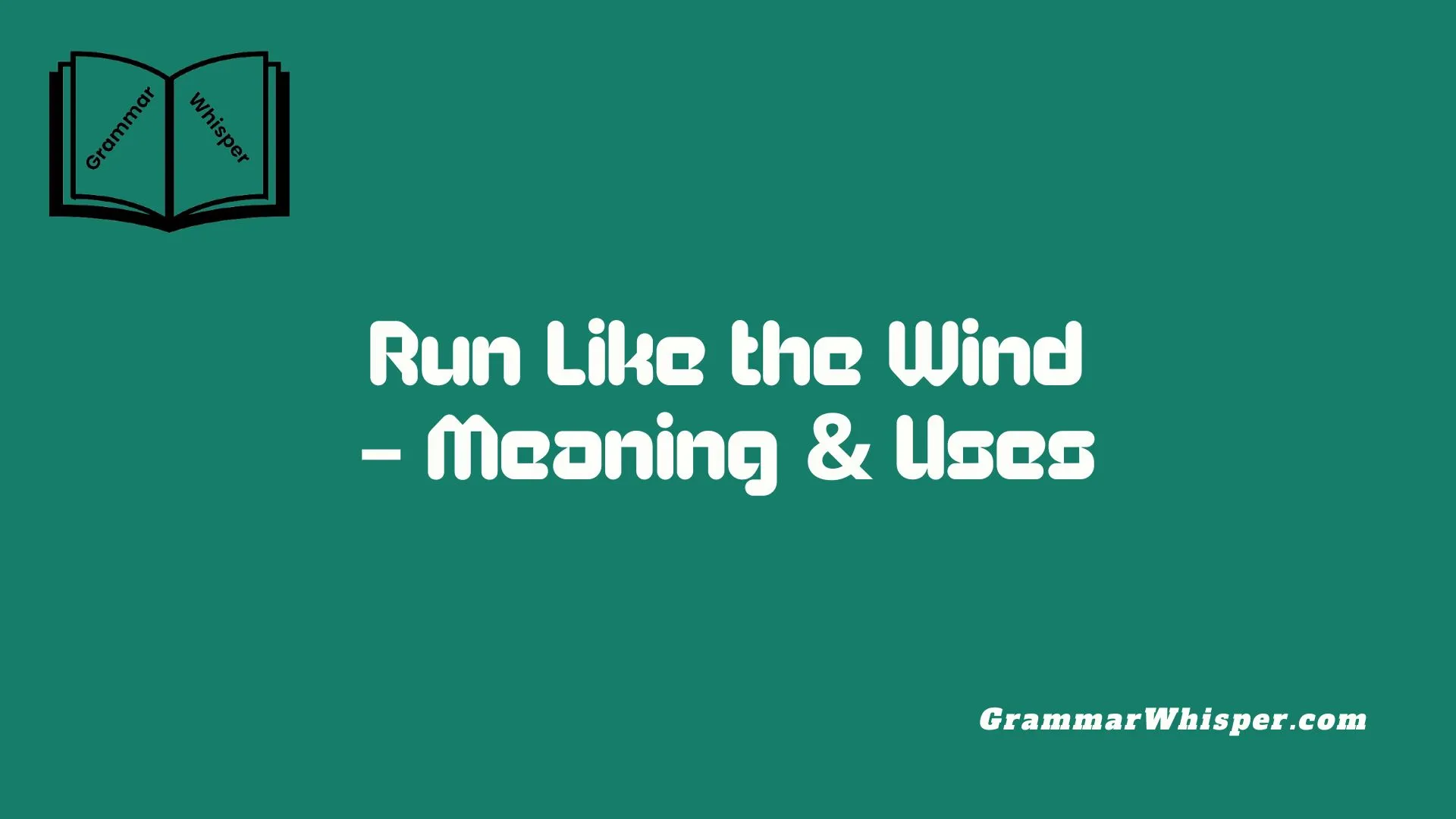The phrase “Run Like the Wind” has long captivated English speakers through its poetic charm and the vivid mental image it inspires. It’s more than an expression – it’s a burst of motion, speed, and urgency wrapped in just a few words. This idiom has endured the test of time, living through many centuries and finding relevance in all kinds of contexts. Whether it’s a tense chase scene in a film, a dramatic moment in a novel, or a runner trying to escape danger, the cultural presence of this phrase is undeniable. As a writer, I’ve personally leaned on this vivid phrase to confidently and accurately depict fast movement when plain language won’t do the moment justice.
Its strength lies in how naturally it resonates strongly across spoken and written speech. In storytelling, everyday conversation, and descriptive writing, “run like the wind” delivers a punch. I often reference this guide when teaching idiom usage, especially to show how the right metaphor can breathe life into language. Though the origins of this idiom remain a mystery buried in time, its modern meaning is clear – it signals unstoppable force and raw emotion. The versatility, emotional weight, and expressive power of the phrase make it a permanent part of how we describe high-stakes, high-speed moments.
What Does “Run Like the Wind” Really Mean?
“Run like the wind” means to run extremely fast – so fast it’s as if the person is being propelled by the wind itself or is as swift as the wind. The expression suggests natural grace, unparalleled speed, and fluid movement.
Key Elements of the Meaning
| Element | Interpretation |
| Run | To move swiftly on foot |
| Like | Introduces a simile, a comparison using “like” |
| The Wind | Symbolizes speed, force, and uncontainable energy |
This idiom can be used both literally and figuratively. Literally, it describes someone running very fast (e.g., a sprinter). Figuratively, it might describe someone fleeing from a situation or acting with sudden urgency.
Examples:
- She ran like the wind to catch the last bus.
- The kid took off like the wind as soon as school ended.
The Origin Story: Where Did “Run Like the Wind” Come From?
Tracing idiomatic origins is often like chasing shadows – but “run like the wind” has surprisingly deep roots in literature.
Historical Milestones
- First Known Use: The Oxford English Dictionary dates the phrase’s use as early as the late 19th century, but variations likely existed orally long before then.
- Earliest Printed Example: One of the earliest appearances of the phrase is in Emily Brontë’s Wuthering Heights (1847): “I’ll be as dirty as I please: and I like to be dirty, and I will be dirty!” said Catherine. “I’ll run like the wind, and be away before you can catch me.”
- 19th Century Military & Cowboy Slang: It also appeared in early American vernacular, especially in the Old West, to describe horses running fast – likely due to their close connection with nature and the elements.
- Literary Echoes: Romantic and Victorian poets often used wind metaphors to express escape, freedom, and speed.
“Run Like the Wind” in Global Languages and Cultures
Idioms are culture-rich expressions, but the concept of moving with wind-like speed exists in many other languages too.
Cross-Language Equivalents
| Language | Idiomatic Equivalent | Literal Translation |
| Spanish | Correr como el viento | Run like the wind |
| French | Courir comme le vent | Run like the wind |
| Chinese | 跑得像风 – 样 (pǎo de xiàng fēng yí yàng) | Run like the wind |
| Japanese | 風のように走る (kaze no yō ni hashiru) | Run like the wind |
| Arabic | يركض كأنّه الريح (yarkud ka’annahu al-rīh) | He runs as if he is the wind |
The universality of wind as a metaphor for speed and freedom underscores why the English idiom has such resonance.
The Linguistic Power of Simile: Why “Run Like the Wind” Works
“Run like the wind” is a simile, a type of figurative language that compares two things using “like” or “as.”
Why It’s Effective
- Sensory Connection: Most people know how wind feels – fast, sometimes forceful, and impossible to stop.
- Visual Imagination: The phrase evokes clear mental imagery, enhancing the vividness of storytelling.
Emotional Impact: It suggests not just speed, but also urgency, determination, or joyous freedom.
Comparisons to Similar Similes
| Simile | Emotion/Context |
| Fast as lightning | Sudden, explosive speed |
| Quick as a flash | Instant reaction |
| Like a bat out of hell | Frantic, uncontrolled urgency |
| Run like a deer | Graceful and nimble |
Figurative Language in Action: Everyday Use Cases
“Run like the wind” isn’t just poetic – it’s practical. It appears across conversations, media, sports, and even business lingo.
Where You’ll Hear It
- Sports Commentary: “And there goes Jackson – he’s running like the wind down the sideline!”
- Casual Speech: “When the bell rang, the kids ran like the wind to get outside.”
- Books & Film: Used to evoke a character’s vitality or escape.
- Marketing & Advertising: “These sneakers will have you running like the wind.”
In Literature and Media: Where It Lives on the Page and Screen
The idiom has been immortalized in various forms of literature, music, and pop culture.
Examples from Books and Films
| Source | Quote/Usage |
| Wuthering Heights (1847) | “I’ll run like the wind…” |
| Spirit: Stallion of the Cimarron (2002) | “Run like the wind, Spirit!” |
| Run Like the Wind by Christopher Cross (Song, 1980) | “Ride like the wind…” |
| The Wind in the Willows | Descriptions of creatures darting like the wind |
The Role of “Run Like the Wind” in Motivation and Expression
Metaphors involving speed are often used to uplift, motivate, and energize.
How It Inspires
- In Sports: Coaches use it to push athletes to give their all.
- In Parenting: Parents encourage kids during races or active play.
- In Motivation: Used to suggest momentum and unstoppable energy.
“Go out there and run like the wind. Leave it all on the track!”
These uses help build confidence, highlight urgency, and motivate quick action.
When Not to Use It: Misuse, Overuse, and Misinterpretations
Like all idioms, “run like the wind” can lose impact when overused or misapplied.
Common Pitfalls
- Overuse in Writing: Using it repeatedly can make prose feel tired or unoriginal.
- Wrong Context: Using it to describe slow or methodical tasks feels jarring.
Cliché Traps: In overly sentimental writing, it can feel trite.
Better Alternatives in Certain Situations
| Scenario | Better Expression |
| Fast decision-making | “At lightning speed” |
| Sleek design or software | “Moves with seamless efficiency” |
| Energetic conversation | “Came out firing” |
Modern Adaptations: How “Run Like the Wind” Continues to Evolve
The phrase hasn’t stayed locked in the past. It’s evolved in how it’s used – especially in digital contexts.
Examples from Pop Culture & Internet
- Memes & Captions: “When you’re late for work and the coffee kicks in – run like the wind!”
- Parodies: Used humorously to describe everything from toddlers to pets.
- Social Media Posts: Hashtags like #RunLikeTheWind used in fitness communities.
Quick Reference: Synonyms and Related Expressions
Sometimes, you want variety. Here are idioms that carry similar meanings and tones.
| Idiom | Connotation |
| Like a rocket | Technological or explosive speed |
| Faster than the eye can see | Superhuman swiftness |
| In the blink of an eye | Extremely rapid action |
| Burn rubber | Associated with vehicles and aggression |
Practical Examples for Everyday Speaking and Writing
Knowing how to use an idiom is one thing – seeing it applied is another.
Usage Examples by Context
| Context | Sentence Example |
| Sports | “She ran like the wind in the final 100 meters.” |
| Casual Talk | “The dog ran like the wind when the door opened.” |
| Writing | “His heart pounded, and he ran like the wind from danger.” |
| Business Metaphor | “With our new funding, we’re going to run like the wind.” |
The Psychology Behind Speed Metaphors
Humans have always associated speed with power, freedom, and escape. That’s why idioms like “run like the wind” work so well.
Psychological Associations
- Freedom: Wind has no boundaries.
- Momentum: Suggests progress, movement, drive.
- Energy: Wind symbolizes natural, unstoppable force.
Using this idiom can subconsciously evoke those feelings in your audience.
Summary: Why “Run Like the Wind” Still Captures Imagination
From Brontë to memes, “run like the wind” endures because it communicates something universal: the human desire to move, to escape, to achieve speed and freedom.
Whether you’re crafting a compelling story or cheering on a friend, this idiom delivers emotional power, visual richness, and unforgettable rhythm.
So go ahead – next time you need a phrase that evokes motion, run with it.
Bonus Section: Idioms That Pair Well With “Run Like the Wind”
Combining idioms can enhance the impact of your communication – when used tastefully.
Great Idioms to Combine
- “Hit the ground running” – Ideal for new beginnings
- “Off to the races” – A quick, energetic start
- “Making great strides” – For progress and advancement
- “Keep your foot on the gas” – Momentum and persistence
Sources and Further Reading
- Wuthering Heights by Emily Brontë – Project Gutenberg
- Cambridge Dictionary – Run Like the Wind
- Christopher Cross: Ride Like the Wind Lyrics
Final Thoughts
The idiom “run like the wind” remains a powerful linguistic tool that fuses imagery, speed, and emotion into a simple phrase. It has stood the test of time thanks to its clarity, vividness, and universal relatability. Whether you’re using it to describe an Olympic sprinter, a child darting across a playground, or a business moving at rapid pace, the expression captures pure momentum.
Its historical presence in classic literature, global cultures, and modern media shows how deeply embedded it is in our communication. So, the next time you need to express speed or urgency with a poetic flair, this idiom will serve you well.
FAQs
What does “run like the wind” mean?
“Run like the wind” means to run very fast – so fast that it feels like you’re being propelled by the wind or moving as swiftly as the wind itself. It can be used both literally and metaphorically.
Where does the phrase “run like the wind” come from?
The phrase has literary roots dating back to at least the 19th century. One of the earliest printed uses is found in Wuthering Heights by Emily Brontë. It also gained popularity in Western slang, especially in relation to horses and riders.
Is “run like the wind” used only in English?
No. Variations of this idiom exist in many languages, including Spanish (correr como el viento), French (courir comme le vent), and Chinese (跑得像风 – 样), all carrying similar meanings of speed and fluidity.
Can “run like the wind” be used in formal writing?
It can, depending on the tone. In creative writing, storytelling, or marketing, it adds vivid imagery. However, in highly technical or formal academic writing, it’s better to use more literal terms like “accelerate rapidly” or “move at high speed.”
What are some alternatives to “run like the wind”?
Here are a few idiomatic alternatives:
- “Like a bat out of hell” – intense and fast, often chaotic
- “At lightning speed” – extremely fast
- “Quick as a flash” – very quick, often in reaction
- “Burn rubber” – fast, aggressive motion, usually with vehicles











